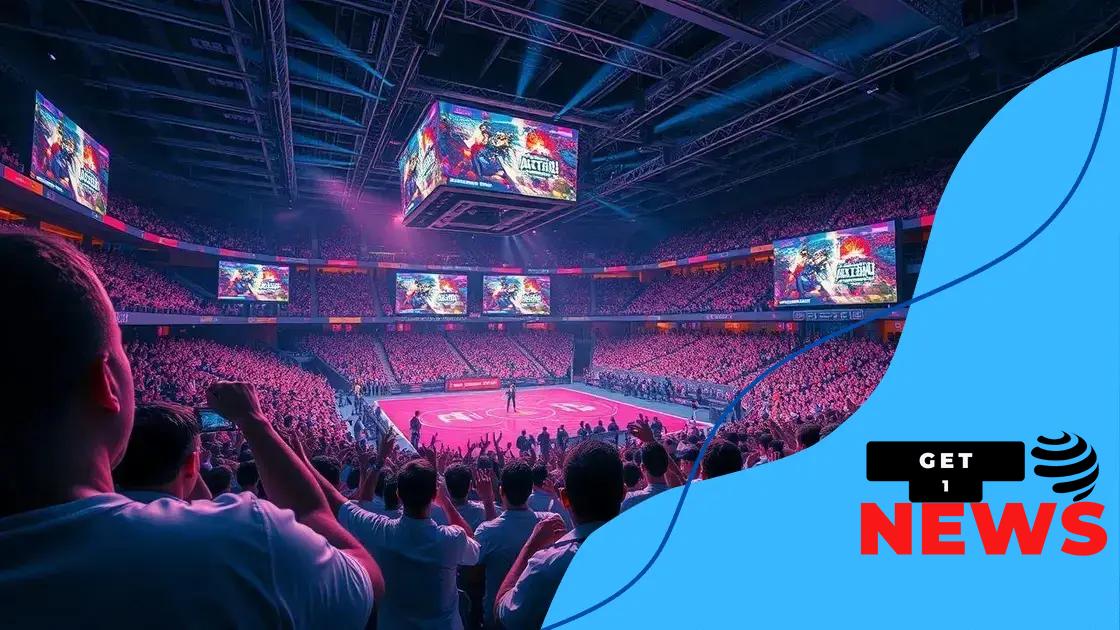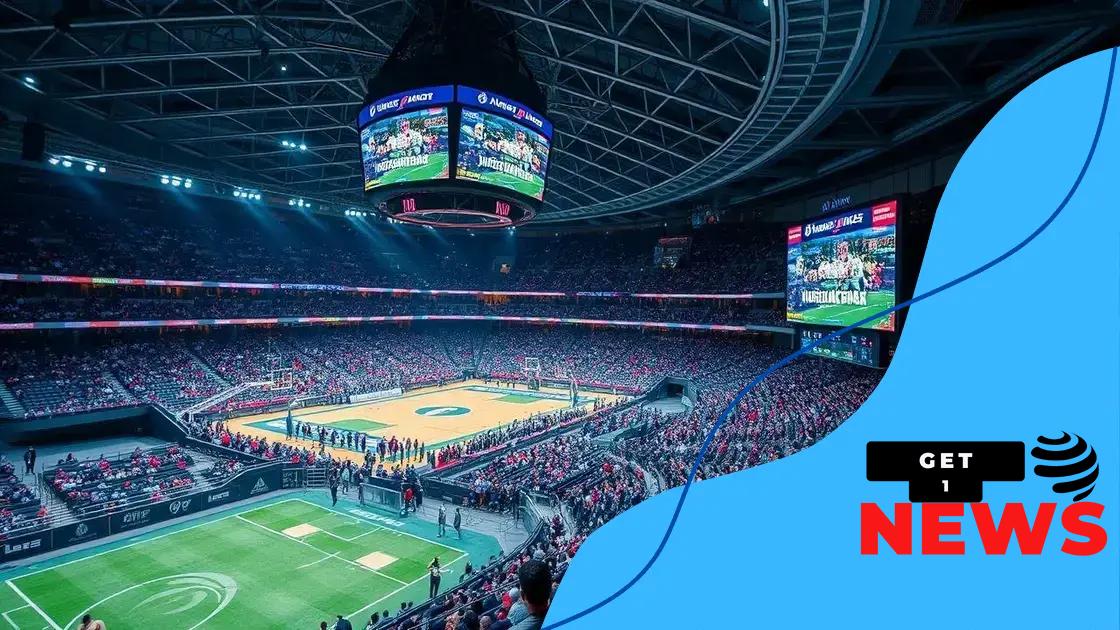How e-sports are influencing mainstream media content

How e-sports are influencing mainstream media content includes increased audience engagement, the rise of interactive experiences, and the integration of traditional sports with e-sports, reshaping marketing strategies and viewer interaction.
How e-sports are influencing mainstream media content is a fascinating topic that reflects the rapid changes in entertainment. Ever wondered how gaming competitions have become a significant part of our media landscape?
Understanding the rise of e-sports
The rise of e-sports has changed the way we view competition and entertainment. From casual gaming to large-scale tournaments, this phenomenon has exploded in popularity. Many people now consider e-sports as a legitimate form of competition, drawing millions of viewers worldwide. So, what has fueled this remarkable growth?
Key Factors in the Growth of E-sports
Several elements have contributed to the rapid expansion of e-sports. First, technological advancements have made gaming more accessible than ever. High-speed internet connections and affordable gaming consoles mean that anyone can join in on the action.
- The rise of streaming platforms like Twitch has created a community around gaming.
- Professional teams are gaining sponsorship and support from traditional sports organizations.
- High-profile tournaments offer massive prize pools, attracting talent and viewership.
Moreover, e-sports organizations are establishing leagues that mimic traditional sports. These leagues provide structure and increase the profile of competitive gaming. Fans enjoy the excitement of watching their favorite teams compete, similar to football or basketball. Additionally, educational institutions are starting to recognize e-sports by offering scholarships and programs.
Demographic Shifts in Viewership
It’s essential to highlight who is watching e-sports. The audience increasingly includes younger generations who grew up with video games. This age group is not only watching e-sports but also actively engaging with the content through social media and forums. As a result, brands and marketers are taking notice, seeking to connect with this expanding audience.
Many traditional media outlets are now incorporating e-sports into their programming. Shows and news segments highlighting major tournaments have become common, bringing increased visibility to the scene. The collaboration between e-sports and mainstream media opens doors for new opportunities and cross-promotional efforts that benefit both industries.
Key e-sports events and their media coverage
Numerous key e-sports events have emerged as pivotal moments in the gaming calendar, drawing significant media attention and huge audiences. Events like the League of Legends World Championship and The International for Dota 2 have transformed from niche competitions into major global spectacles.
Impactful E-Sports Tournaments
These tournaments showcase the best players and generate excitement across the gaming community. The League of Legends World Championship, for example, consistently sells out arenas and is streamed to millions online.
- Major tournaments often feature multi-million dollar prize pools.
- They attract sponsorships from well-known brands.
- Viewership can rival traditional sports finals, creating substantial media buzz.
Media coverage of e-sports has evolved significantly. With platforms like Twitch and YouTube Gaming, fans can watch live broadcasts and recap highlights. This accessibility has not only expanded the audience but also enhanced engagement. Not just gamers watch these events; fans from all walks of life tune in, making e-sports a unique fusion of entertainment.
Media Partnerships and Broadcasts
Partnerships between e-sports organizations and traditional media outlets are becoming increasingly common. Networks like ESPN now feature e-sports segments, further legitimizing competitive gaming in the mainstream. Viewers can find e-sports on multiple platforms, from online streaming to cable television, ensuring broad exposure.
Various platforms host live commentary and analysis, enriching the viewing experience. Fans appreciate this added context as it helps them understand the game’s intricacies. They can engage with fellow fans in real-time through chats and social media platforms, creating a community atmosphere.
Impact of e-sports on traditional sports

The impact of e-sports on traditional sports is profound and far-reaching. As e-sports continue to grow in popularity, they influence various aspects of traditional sports, from audience engagement to marketing strategies. Many traditional sports organizations are beginning to recognize the significance of e-sports in today’s entertainment landscape.
Changing Audience Dynamics
One of the major effects is a shift in audience demographics. Younger fans gravitate towards e-sports, which attracts them through streaming platforms and interactive content. This shift encourages traditional sports teams to connect with younger viewers by incorporating gaming elements into their marketing.
- Teams collaborate with e-sports organizations to host joint events.
- Merchandising strategies are increasingly influenced by popular gaming franchises.
- Fan engagement initiatives mirror those found in e-sports, like live streaming alerts.
As e-sports attract vast audiences, traditional sports leagues are taking notes on how to enhance their appeal. For instance, some leagues now offer fantasy competitions similar to those found in e-sports, increasing interaction among fans.
Complementary Events
Moreover, traditional sports organizations have begun to host e-sports tournaments. These events not only draw in gaming fans but also introduce e-sports to sports enthusiasts who may not have been exposed to competitive gaming before. The result is a broader fan base that celebrates both pursuits.
The challenge for traditional sports lies in adapting to this rapidly changing landscape. While they strive to maintain their legacy, incorporating elements of e-sports can prove beneficial. Innovations like augmented reality during live events and interactive fan experiences can further bridge the gap between the two worlds.
How companies leverage e-sports for marketing
Companies are increasingly finding innovative ways to leverage e-sports for marketing. As the e-sports industry flourishes, brands recognize the potential to reach a highly engaged audience that spans different demographics. By tapping into this growing market, companies can enhance their visibility and improve brand loyalty.
Targeting Young Consumers
Many brands focus on the younger demographic that consistently participates in e-sports. This audience is tech-savvy and often values authenticity and engagement over traditional advertising. Companies develop marketing strategies that resonate with this group, integrating their products into the gaming experience.
- Advertising during live streams can capture instant attention.
- Branded content in popular games can create immersive experiences.
- Hosting or sponsoring tournaments allows brands direct engagement with fans.
These tactics not only promote products but also create a strong connection with the audience, making marketing efforts more effective.
Building Strategic Partnerships
Partnerships between companies and e-sports teams are also common. When brands align themselves with popular teams, they tap into a loyal fan base. This collaboration can enhance brand image and reach a larger audience. For example, a beverage company that sponsors a well-known team benefits from heightened visibility each time the team plays.
Moreover, companies often engage in co-branded merchandise. Fans love to show support for their favorite teams by purchasing products featuring both the team and the sponsor’s branding. This not only boosts sales for the company but also fosters a sense of community among fans.
Engaging with the Community
In addition to traditional marketing strategies, engaging with gamers on social media platforms can amplify a brand’s reach. Companies leverage platforms like Twitter and Instagram to create campaigns that encourage audience interaction. Running contests, sharing memes, and highlighting user-generated content are effective ways to engage fans.
Furthermore, creating content around e-sports trends, such as game releases or tournament highlights, can keep the brand relevant. By aligning themselves with current events in the e-sports world, companies can maintain a strong connection with their audience, ensuring long-term brand loyalty.
Future trends in media and e-sports
The future trends in media and e-sports are shaping a dynamic landscape where technology and entertainment intersect. As e-sports become more mainstream, we can expect several exciting developments that will change how we engage with both media and gaming.
Increased Integration of Virtual Reality
One trend is the rise of virtual reality (VR) in e-sports. As VR technology advances, it will allow players and audiences to immerse themselves in competitions like never before. Fans will experience matches from the player’s perspective, making it feel as if they are part of the action. This immersive experience can enhance viewer engagement and attract new fans.
- VR platforms may host fully interactive tournaments.
- Brands will use VR for advertising within games.
- Live audience experiences could shift from passive watching to active participation.
Such changes could revolutionize how e-sports are broadcasted and experienced, introducing unique advertising opportunities.
Growth of Interactive Content
Another trend is the growth of interactive content. Gamers enjoy not only playing but also influencing the outcome of events. Companies are likely to create more interactive viewing experiences, allowing fans to play alongside their favorite teams or vote on in-game decisions.
This interaction can lead to higher engagement rates, as fans feel more connected to the game. Additionally, incorporating social media features where viewers can share live reactions or collaborate with other fans will enhance community bonds.
Expansion of Broadcasting Platforms
As e-sports continues to grow, more dedicated broadcasting platforms will emerge. Companies may shift focus from traditional cable to online streams, improving accessibility for fans worldwide. E-sports might lead to tailored content that caters to specific fan preferences, generating a personalized viewing experience.
Moreover, partnerships with tech companies will allow better streaming quality and richer content. This could include in-depth analysis, player stats, and real-time interactions, making broadcasts more engaging for viewers.
The landscape of media and e-sports is continually evolving, and it’s clear that exciting changes are on the horizon. As technology advances, we can expect more immersive experiences for players and fans alike. The integration of virtual reality and interactive content will likely redefine how we engage with e-sports. Additionally, the growth of new broadcasting platforms will make these competitions more accessible to everyone. It’s an exciting time to be a part of this transformation, as both traditional and e-sports find ways to innovate and connect with audiences in fresh, engaging ways. The future looks bright for e-sports and its impact on the media world!
\n\n\n
\n
\n
FAQ – Frequently Asked Questions about E-Sports and Media
What are some future trends in e-sports?
Future trends include increased virtual reality integration, interactive content, and the growth of dedicated broadcasting platforms.
How are companies using e-sports for marketing?
Companies leverage e-sports for marketing by engaging with younger audiences through sponsorships, interactive campaigns, and brand collaborations.
What is the impact of e-sports on traditional sports?
E-sports attract younger fans, prompting traditional sports to adapt their marketing strategies and engage with fans through joint events.
Why is accessibility important in e-sports?
Improved accessibility allows a wider audience to engage with e-sports, making it easier for fans to watch tournaments and participate in the community.





